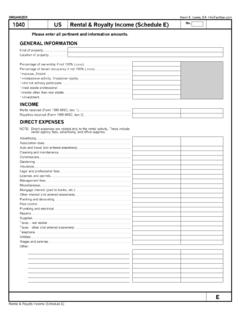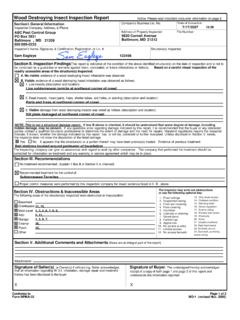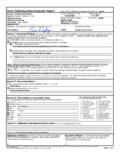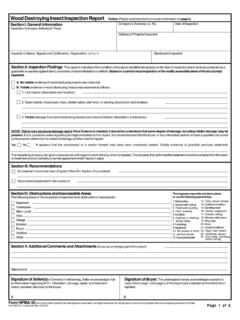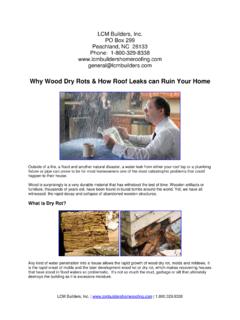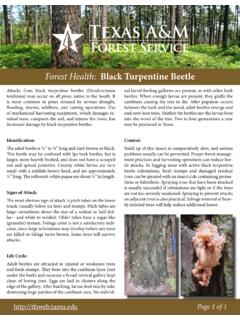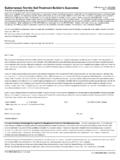Transcription of BOOK 2 INSPECTOR’S GUIDE SERIES - Hilo Hawaii
1 book 2 inspector S GUIDE SERIES Practical help for the real estate industryCHRISTOPHER RITHERI sland Inspection of contents INTRODUCTION (destructive forces).. 1 FIRE .. 1 2 PESTS .. 3 DEFERRED MAINTENANCE .. 6 6 PREOBLEM AREAS .. 7 OVERGROWN LANDSCAPING .. 7 Identification of components .. 7 Common problems identified .. 7 Maintenance and repair recommendations .. 7 ROOFS FLAT ROOFS .. 8 SLOPED ROOFS .. 8 Common problems identified .. 9 Maintenance and repair recommendations .. 10 GUTTERS Identification of components .. 13 Common problems identified .. 14 Maintenance and repair recommendations .. 14 WORN PAINT STAINS AND CAULKING Identification of components.
2 15 Common problems identified .. 15 Maintenance and repair recommendations .. 17 PLUMBING Identification of components .. 18 Common problems identified .. 18 Maintenance and repair recommendations .. 19 ELECTRICAL Identification of components .. 22 Common problems identified .. 22 Maintenance and repair recommendations .. 22 DECKS AND STAIRS Identification of components .. 23 Common problems identified .. 23 Maintenance and repair recommendations .. 24 FOUNDATION AND EROSION PROBLEMS Identification of components .. 24 Common problems identified .. 25 Maintenance and repair recommendations .. 25 INTERIOR Identification of components .. 26 Common problems identified .. 26 Maintenance and repair recommendations .. 27 CONCLUSION .. 28 1 INTRODUCTIONThe majority of the world s population lives in buildings owned by some-one else.
3 The idea of owning one s own home is often just a dream formost people. When people decide to buy their own home the task can bedaunting. The purchase of a house is often the largest amount of moneythey will spend in their lifetime. Usually, the first institutions they willcontact will be a real estate office and a bank loan office. Basically, thebank will help them find the money, and the realtor will help them find thehouse. Yet there are a number of other professionals that will be involvedin the process. For the purpose of this book , we are going to focus on thehome inspector and, more specifically, on what is discovered in the inspec-tion the real estate industry, the appraiser is usually called in to provide anestimate on the monetary value of the home.
4 They will take a generaloverview of the size and condition of a home and then find comparablehomes sold recently in the general area. However, the most important valueis truly set in the mind of the prospective buyer and seller. A seller can setthe price they desire for the house, and the buyer will often have a predeter-mined price range, location and design in mind. A range of factors willaffect the decision-making process of the buyer, including location,design, style, materials used, condition of property, school districts, avail-ability of services and general upkeep of the a buyer decides to buy a house, they will usually make an offeron the price they are willing to pay. When the buyer and seller finallyagree to a price, the house will enter into the escrow process.
5 During thistime, the prospective buyer will be given a set time for their duediligence period. It is during this time that they can have the houseinspected and checked for other areas that may be of concern. The timeallowed for this process is usually ten to fourteen days for the purchase ofa residential property and can be as long as a few months for buyer s main concern when hiring a home inspector is to discoverany problems or deficiencies found in the house and to learn more aboutthe structure and operational systems. After the inspection is done, thebuyer can decide to go on with the purchase, or use the findings as a wayto renegotiate price or ask for further repairs. Each state will have itsown laws in regard to the inspection process and whether or not the reportcan be used as a negotiation begin this portion of the book , we will cover the five most destruc-tive forces in the building industry and then cover common problems foundin the homes of who has seen a building after a structural fire can attest to itsdestructive nature.
6 The effects of the fire, heat, and smoke will destroyeverything if left burning long enough. Over the years many building2regulations have been focused on limiting the possibility of fire and firedamage. Even a small fire can cause smoke damage throughout the speaking, there are not many houses that have been rebuilt aftera large fire. If there is no indication of a past fire in the disclosure state-ment, there is no real way of determining past fire damage, since most ofthe damaged items will have been repaired or you mention Hawaii , most people think of beaches, palm trees,sun and water. For those who live in Hawaii , there are many other thingsthat come to mind. The moderate climate, beautiful surroundings, and slowpace of living can truly make it a paradise in many people s minds.
7 Yet,when it comes to buildings, there is probably no greater destructive forcein Hawaii than water and the sun. Water can turn from a blessing to acurse, especially in the areas of flooding, leaking, and flood quickly demonstrates the destructive force of water. During aflood the water does more than just knock things over and get everythingwet. The water can also contain dirt, debris, mud, bacteria, pests, rocksand other unwanted items. When the flow of water becomes strong enough,it can knock buildings off their foundations, shift the building structure andcontents, and even move the house to another piece of property! After aflood there is often a large amount of mud and other debris left after cleaning everything up and repairing damaged items, the watercan cause lingering problems.
8 Mold, insects, decay, and bacterial growthcan occur, especially inside the walls and inside enclosed hard-to-reachareas. The problems caused by a flood can continue for months after theinitial problem caused by water and flooding is that of erosion of thesoil away from the footings and foundations of a house. When water flowsacross open soil, it takes part of the soil away with it. The greater the flowof water, the greater the erosion. The more unstable the soil, the greater theerosion. If there is no feasible way to divert water, a ground cover can be used toprotect the soil from erosion. The presence of water near a foundation canattract wood-destroying insects and soften the ground, which increases thelikelihood of further soil displacement by animals, nature, and people.
9 Ifthe soil continues to be undermined from the foundation, the building itselfcan begin to sag, shift, and, if the slope is great enough for movement, most common form of water damage occurs over time. Water fromleaking areas, driving rains, plumbing leaks and from roof/gutter prob-lems will often begin to cause problems slowly over time. The plumbingsystem of a home most commonly uses pipes made of copper, PVC plastic,or galvanized metal. The flow of water away from the house is governedby a drain system made up of either ABS plastic pipe or cast iron leaks are caused by pipes or fixtures with faulty seams, washers, orphysical damage. When these areas leak, the items nearby can become mildlywet or even saturated.
10 When this happens the physical properties of thewet items begin to break down and become a breeding ground to destruc-tive mold, fungus, mildew, plant growth and other unwanted the wet sides of Hawaii , it can rain as much as 100 inches or more ayear. In the ideal situation, rain is moved away from the house through theroofing and guttering systems and by the presence of paint and other seal-ants. When roofs, gutters, caulking, stains, and paints become old and wornthey allow the water to penetrate the wood and metal underneath. If theleak and water penetration areas are allowed to continue, they will causemany problems, including damage to wood and fixtures, mildew growth,swelling, peeling, dry rot, erosion, rusting, and, eventually, structural destructive force of the sun can most readily be seen by looking atits effect on paint and faded carpet areas near windows.
